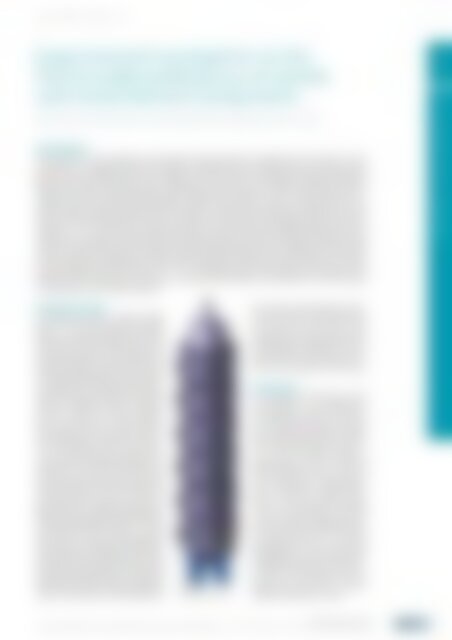atw - International Journal for Nuclear Power | 04.2023
Umwelt, Klima, Energiesysteme Betriebsergebnisse 2022
Umwelt, Klima, Energiesysteme
Betriebsergebnisse 2022
Sie wollen auch ein ePaper? Erhöhen Sie die Reichweite Ihrer Titel.
YUMPU macht aus Druck-PDFs automatisch weboptimierte ePaper, die Google liebt.
<strong>atw</strong> Vol. 68 (2023) | Ausgabe 4 ı Juni<br />
Experimental Investigation on the<br />
Pool Scrubbing Behaviour of soluble<br />
and mixed Aerosol Components<br />
René Vennemann, Michael Klauck, Tobias Jankowski, Hans-Josef Allelein, Marco K. Koch<br />
Introduction<br />
The retention of aerosol particles and especially of fission products in liquid pools, also known as pool<br />
scrubbing, is an employed process in the frame of postulated severe accident scenarios in nuclear power<br />
plants. In case of a boiling water reactor (BWR), the reactor pressure vessel (RPV) is equipped with Safety<br />
Relief Valves (SRVs), that might reduce undesirable pressure increases in the RPV by gas release into the<br />
suppression pool and thereby maintaining the cooling circuits’ integrity. In case of a postulated severe accident<br />
scenario, the suppression pool has the function to condensate steam from the gas flow and to scrub<br />
fission products from the gas flow be<strong>for</strong>e it is released to the containment atmosphere. Beside this scenario<br />
Gupta et al. [GUP23] describe more postulated accident scenarios where pool scrubbing phenomena can be<br />
expected, <strong>for</strong> example in a steam generator tube rupture scenario or as part of a filtered containment venting<br />
system. The focus of this work is to expand the experimental database on pool scrubbing and to discuss the<br />
aerosol retention <strong>for</strong> individual size classes. Most experiments available in the open literature are carried<br />
out with insoluble particles like SnO 2 [HER18, REH22] . Consequently, this work focusses on the retention of the<br />
soluble CsI and a mixture of CsI and SnO 2 to enhance the knowledge on the behaviour of aerosols typical<br />
<strong>for</strong> postulated severe accident scenarios<br />
RESEARCH AUS DEN AND UNTERNEHMEN<br />
INNOVATION 71<br />
SAAB test facility<br />
The SAAB test facility is shown in figure<br />
1 [ALL18] . The test vessel has a modular<br />
design; thus the pool height can be varied<br />
from 2.25 m to 6.25 m and the distance to<br />
the measuring device at the outlet can be<br />
kept almost identical. Due to five identical<br />
one-meter-high segments the test vessels’<br />
total height can be changed while the gas<br />
space above the pool is kept at a constant<br />
volume. In addition to the five identical<br />
parts the vessel has a bottom segment<br />
with a gas inlet and a conical top part<br />
with openings <strong>for</strong> measurement devices.<br />
The inner diameter of the test vessel is<br />
1.5 m, and the maximum possible water<br />
volume is 10 m³. The injection nozzle is situated<br />
0.75 m above the vessels’ floor and<br />
is upward directed. The inner diameter of<br />
the nozzle outlet is 0.021 m. Aerosols are<br />
generated with a spraying system (soluble<br />
particles) and with a particle disperser<br />
with brush (insoluble particles) [ALL20] and<br />
afterwards fed into a mixing chamber,<br />
where they are conditioned and blended.<br />
During this process additional carrier gas<br />
and steam can be added. Once the aerosol<br />
passed the mixing chamber it is measured<br />
with an Electrical Low-Pressure Impactor<br />
(ELPI+) from Dekati, which determines<br />
| Fig. 1<br />
SAAB test vessel [ALL18].<br />
the aerosol concentration <strong>for</strong> fourteen<br />
size classes, and is injected into<br />
the water pool of the vessel. After<br />
passing the water pool, the aerosol is<br />
measured by a second ELPI+ system,<br />
located 0.625 m above the pool surface<br />
in the conical part of the vessel.<br />
Experiment<br />
A pool height of 2.25 m up to 6.25<br />
m is realized, i.e. the submergence<br />
of the injection nozzle is 1.5 m up to<br />
5.5 m. Nitrogen is used as carrier gas<br />
and is injected with 20 m³/h (5.56 x<br />
10 –3 m³/s) up to 80 m³/h (2.22 x 10 –2<br />
m³/s). Thus, the Weber number is<br />
approximately 5 x 10 4 – 8 x 10 5 . The<br />
tests are per<strong>for</strong>med with an ambient<br />
pool temperature (approximately<br />
22 °C) and with caesium iodine<br />
(CsI) or a mixed aerosol consisting<br />
of 60 mass percentage CsI and 40<br />
mass percentage tin dioxide (SnO 2 ).<br />
As in previous tests [VEN22] the inlet<br />
gas temperature is 30 °C and to keep<br />
the humidity on a constant level, the<br />
sampling temperature of the ELPI+<br />
is at 60 °C. The experiment was repeated<br />
more than once, to obtain<br />
reliable measurement results.<br />
Research and Innovation<br />
Experimental Investigation on the Pool Scrubbing Behaviour of soluble and mixed Aerosol Components ı René Vennemann, Michael Klauck, Tobias Jankowski, Hans-Josef Aus den Allelein, Unternehmen<br />
Marco K. Koch
















